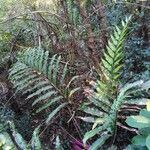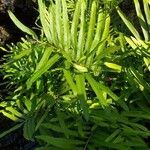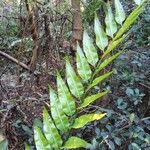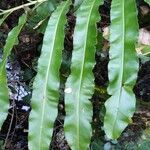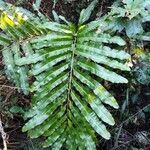Terrestrial or subaquatic fern, growing in clumps, sometimes gregariously occupying an area. Rhizome short or long, erect, or shortly prostrate, then erect at the bud/frond base, 6 cm or more diam., up to 30 cm height or taller, covered with scales of various sizes and aerenchymatous strut-roots. Broader scales ovate-oblong, 6-30 by 3-12 mm; apex acute to obtuse, usually abraded; margin always abraded, possibly entire at the early stage; basifixed; mid-cells thick dark brown-black arranged in broad array, the thickest in the centre; marginal cells clathrate light brown-golden, arranged in wide or thin array, sometimes much abraded, so that the scales look as if they only consist of thick black cells. Narrower scales linear to needle shaped, 1.9-17 by 0.5-2 mm, apex acute, margin apparently entire, but always abraded; basifixed; apparently both kinds of scales derived from same origin. The abrasion of the marginal-clathrate cells on a young scale, while the thickened middle cells are few, will result in a linear form of scale. This can be observed on young scales around the stipe with only few thick middle cells, with ovate, not linear form. The very young scales are even throughout with clathrate cells without any thickened middle cells. Stipe 21-125 cm long and 0.2-2.6 cm diam.; rudimentary pinnae 1-14, alternate, the lowest 1-23 cm from caudex, usually dark, blackish coloured; hairs (trichomes) fine colourless to light golden coloured, abundant on the base of small sized stipes, and much reduced in number toward frond apex; but absent on big sized stipes. Frond pinnate, 36-over 300 cm long, pinnae 3-29, alternate, imparipinnate, stalked, large, lanceolate or narrow-oblong, entire, thick-coriaceous, the apical pinnae similar to the lateral, a few reduced glandular pinnae that function in young fronds represented by short residual spines on the stipe; basal pinnae ± the largest, gradually reducing in size toward apex, pinnae only sterile, only fertile, or sterile pinnae on basal portion of lamina and fertile pinnae on the apical portion. Lateral sterile pinnae linear, ensiform, subulate, narrowly ovate 6-64 by 1.1-9 cm, base acute-obtuse-oblique, apex acute, acuminate (with or without short or long drip tip), obtuse, acuminate, emarginated, to truncate (with or without mucro), margin entire; midrib glabrous; stalk 0.2-1.5 cm long, glabrous; terminal pinna sometimes pinnatifid without stalk, sometimes decurrent; areoles 5-21 from midrib to margin, arranged at 50-60° toward midrib, and widening up to 90° on broad pinnae, the first areole adjacent to the midrib linear, 2-9 by 0.1-0.7 mm, the second and third more or less broader, 0.5-5 by 0.3-1.5 mm, the areoles in the middle between midrib and margin linear, 1.4-6.1 by 0.3-1.3 mm, the marginal areoles smallest, 0.4-1.75 by 0.2-1 mm; abaxial and adaxial surface of pinnae glabrous. Fertile pinnae linear, lanceolate, subulate to long ovate, 6-46 by 1-6.5 cm, base acute, obtuse, or oblique, apex acute-acuminate-obtuse, with or without mucro, margin entire; stalk 0.3-1 cm long, or without stalk when terminal and pinnatifid, glabrous, or few with trichomes; abaxial side of lamina covered entirely or partly by acrostichoid sporangia, except the midrib, small part of the lamina base and the mucro. Partly fertile pinnae usually present in between the completely sterile and completely fertile ones, similar or different in shape from the fertile and sterile pinnae, when different, the sterile base usually broader than the narrower-tapering fertile apical portion; the border between sterile and fertile follows the areole line, usually narrowing down forming an isthmus. Paraphyses between the sporangia with elongated translucent golden-light brown fragile or sometimes dark red stout stalk (Maluku and New Guinea specimens) 0.25-0.35 mm long, apically clavate or variously lobed (? = abortive sporangia). Sporangia short stalked, annulus lined by 16-25 indurated cells. Spores trilete, 37.5-62.5 by 45-65 µm diam., according to Devi (Spores of Indian ferns 1977) 50 by 65 µm and Tryon & Lugardon (Spores of the pteridophyta surface, wal structure, and diversity based on electron microscope study 1991) 42-70 µm, finely scabrate, observation using LM always shows bubbles of spore contents, probably oil.
More
Plants 1-2 m tall. Rhizome erect; scales dark brown to black, broadly lanceolate, 1-2[-4] × 0.2-0.6[-2] cm. Stipe straw-colored to pale castaneous, 10-70[-100] cm, 0.5-1 cm in diam., glabrous upward; lamina 40-50[-300] × 20-40 cm, lateral pinnae to 5-12 pairs; sterile pinnae narrowly oblong, (10-) 15-35[-80] × 1.8-5.5[-8] cm, with stalk 0.5-1.5 cm, thickly leathery, both surfaces glabrous, base cuneate to rounded, margin entire and cartilaginous, apex rounded to retuse and shortly mucronate; costae strongly raised abaxially, flat or slightly grooved adaxially; veins raised abaxially, hardly visible adaxially, closely spaced, copiously anastomosing to form irregular areoles. Fertile pinnae distal on frond, like sterile pinnae but slightly smaller. n = 30, 120.
Stems creeping or ascending, frequently branched. Leaves ± arching, 1--3 m × 12--50 cm. Rachis rounded abaxially, decidedly grooved adaxially. Pinnae 24--30(--40), usually not overlapping, 10--34 × 1.3--7 cm; proximal pinnae always distant, frequently rounded at tip; costal areoles 3 or more times longer than wide; distal 6--12 pinnae of fertile leaves bearing sporangia. Sporangia spread over abaxial surface of distal pinnae in fertile leaves; paraphyses stalked, ending with single isodiametric, irregularly lobed cell. Spores (37--)57(--72) µm diam., surface minutely tuberculate. 2 n = 60.
Rhizome c. 6 mm in diameter, set with hard subulate rhizome-scales c. 10 mm long, with thick black median area and pale narrow clathrate borders. Fronds erect; stipe brown, shallowly sulcate, up to 0.5 m long; lamina up to 1.5 x 0.4 m; sterile pinnae glabrous, linear to cultrate, entire to irregularly undulate, acuminate to truncate, 80-360 x 10-50 mm, base unequally cuneate; costa raised and prominent below, reticulate venation apparent; fertile pinnae borne towards apex of frond, similar to sterile pinnae but with under surface (except costa) covered with sporangia.
Rhizome short-creeping to erect, stout, up to 6 mm in diam., with firm subulate scales up to 10 mm long. Fronds crowded, erect, up to 1.8 m long. Stipe firm, up to 0.5 m long, up to 5 mm in diam., sulcate. Lamina 1-pinnate, up to 1.5 x 0.4 mm, with a free, conform, terminal pinna. Pinnae coriaceous, oblong to cultrate, entire to irregularly undulate, acuminate to truncate, up to 350 x 45 mm, glabrous at maturity, larger pinnae short stalked; fertile pinnae borne towards frond apex; venation reticulate. Sporangia acrostichoid.
A fern with a short to medium creeping rhizome. The rhizome is up to 3 cm thick. It has large fleshy roots. The fronds are erect and up to 4 m long. The leaflets are large, thick and leathery. They are only divided once. They have blunt tips. They often have a yellowish colour. It grows in clumps or spreads out over the ground. Under the uppermost leaves there is often a mass of spores in a brown sugary mass.
Rhizome scales to c. 40 mm long. Fronds to c. 3–4 m tall. Lamina dull green to golden green. Sterile pinnae c. 35 cm long, c. 4–5 cm wide; apex rounded to truncate, usually with a short abrupt point. Fertile pinnae similar in shape but smaller.
